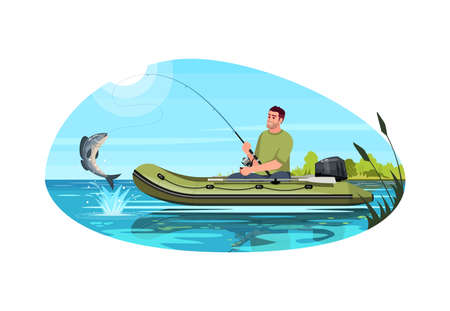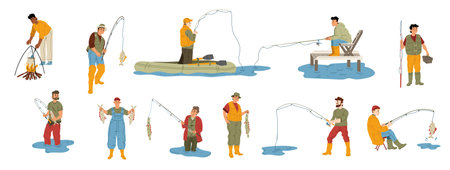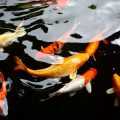1. Introduction: Discovering America’s Untapped Fishing Hotspots
For anglers across the United States, few adventures match the excitement of finding a secret fishing spot teeming with largemouth bass, trout, or other freshwater favorites. While famous lakes and rivers attract crowds every season, America is dotted with hidden freshwater goldmines that many fishermen overlook. These under-the-radar locations—ranging from quiet reservoirs in the Midwest to winding creeks in the South—offer incredible opportunities for those willing to explore beyond the usual destinations.
The Allure of Freshwater Fishing in the U.S.
Freshwater fishing is more than just a pastime; it’s a cherished tradition woven into American culture. Whether you’re casting from a jon boat at sunrise, wading into a secluded stream, or teaching kids how to reel in their first catch, there’s something undeniably special about connecting with nature on the water. Part of the thrill comes from discovery—uncovering that perfect spot where fish are plentiful and competition is scarce.
Why Anglers Love Hidden Spots
Overlooked lakes, rivers, and reservoirs often hold bigger, less-pressured fish. These waters may be off the beaten path or simply overshadowed by more popular locations nearby. For anglers seeking solitude, better catches, or new challenges, these hidden gems offer unique rewards.
What Makes an Untapped Fishing Hotspot?
| Feature | Description | Why It Matters |
|---|---|---|
| Remote Location | Far from busy boat ramps and main roads | Less fishing pressure means healthier fish populations |
| Diverse Habitat | Mossy coves, rocky banks, submerged timber | Variety attracts multiple species (bass, trout, catfish) |
| Limited Publicity | Few mentions online or in guidebooks | Allows for peaceful experiences without crowds |
| Strong Conservation Efforts | Local rules protect fish stocks and habitats | Sustainable angling ensures good fishing year after year |
If you’re ready to break away from the crowd and hunt for your own slice of fishing paradise, America’s lesser-known waters are waiting to be explored. These hidden freshwater goldmines might just become your new favorite fishing destination.
2. Southern Surprises: Secret Bass Havens
The American South is famous for its hospitality and comfort food, but it’s also home to some of the country’s most underrated freshwater fishing spots. Largemouth Bass love these waters, and there are plenty of lesser-known lakes and rivers that even seasoned anglers overlook. Let’s uncover some hidden gems, share local legends, and give you tips to help you hook your next trophy bass.
Hidden Lakes and Rivers Worth Exploring
| Location | State | Local Legend | Best Season |
|---|---|---|---|
| Lunker Lake | Alabama | Rumor has it a 16-pounder lurks beneath the lily pads. | Spring & Fall |
| Cypress Creek | Mississippi | Locals say the “Ghost Bass” comes out at dusk. | Late Summer |
| Piney Woods Reservoir | Texas | A retired sheriff swears by the “midnight bite.” | Early Spring |
| Mossy Branch River | Georgia | An old-timer caught his personal best using a homemade lure. | April – June |
Tried-and-True Tips from Local Anglers
- Go Early or Stay Late: Dawn and dusk are when bass get active, especially in Southern heat.
- Think Like a Local: Don’t be afraid to ask around at bait shops—Southern anglers love sharing stories (and secrets) if you’re friendly.
- Lure Selection: Soft plastics in watermelon or junebug colors work well in stained water common to the region.
- Watch for Cover: Fallen trees, brush piles, and docks are prime hiding spots for monster bass.
- Tweak Your Technique: Slow down your retrieve during hot afternoons; bass can get sluggish in warm water.
Bass Behavior in Southern Waters
Largemouth Bass in the South adapt to warmer temperatures by seeking shade and structure. Shallow coves with overhanging trees or thick vegetation provide cool cover. During colder months, look for deeper holes where bass stack up together.
Your Next Adventure Awaits!
If you’re ready to break away from crowded lakes and try something new, these Southern secret spots just might surprise you with the catch of a lifetime. Pack your tackle box, bring your favorite rod, and get ready for an authentic slice of America’s freshwater goldmines.

3. Trout Country: Underrated Mountain Streams and Lakes
When it comes to trout fishing, America’s mountains hide some of the best-kept secrets. Far from the crowded rivers, these quiet streams and lakes offer wild trout, beautiful views, and peaceful solitude for anglers who know where to look. Let’s explore some of these hidden gems across the Rockies, Appalachians, and Pacific Northwest.
The Rockies: High-Elevation Hotspots
Colorado, Montana, and Wyoming are famous for their mountain scenery, but tucked away in their forests and canyons are crystal-clear creeks teeming with native cutthroat and rainbow trout. Think alpine lakes above treeline or small streams winding through aspen groves. These spots often require a hike but reward you with unpressured fish and stunning backdrops.
Rockies Trout Fishing Highlights
| Location | Trout Species | Special Features |
|---|---|---|
| South Platte River, CO | Rainbow, Brown, Cutthroat | Trophy-sized fish, scenic canyons |
| Bighorn Mountains, WY | Brook, Cutthroat | Remote creeks, wild populations |
| Bitterroot Range, MT | West Slope Cutthroat | Pristine streams, less pressure |
The Appalachians: Eastern Treasures
The Appalachian Mountains might not be the first place that comes to mind for trout fishing, but their cool streams are home to native brook trout—America’s only native eastern trout. In states like North Carolina, Tennessee, and Pennsylvania, you’ll find overlooked blue lines on the map that hold feisty fish and plenty of peace and quiet.
Appalachian Hidden Streams
| Location | Trout Species | Why It’s Special |
|---|---|---|
| Nantahala National Forest, NC | Brook Trout | Lush forests, waterfall pools |
| Pennsylvania Wilds, PA | Brown, Brook Trout | Miles of public access streams |
| Great Smoky Mountains NP, TN/NC | Brook Trout | Historic waters, wild fishery revival |
The Pacific Northwest: Rainforest Streams & Alpine Lakes
The lush landscapes of Oregon and Washington offer an incredible mix of steelhead rivers and secret mountain lakes. Here you can chase wild rainbow trout in mossy rainforests or cast a fly on a snow-fed lake with Mount Rainier in view. Many spots remain lightly fished thanks to their rugged access—perfect for adventurous anglers.
PAC NW Trout Destinations at a Glance
| Spot Name | Main Trout Species | Local Tip |
|---|---|---|
| Mckenzie River, OR | Rainbow Trout (Wild) | Caddis hatches in late spring are legendary! |
| Naches River Tributaries, WA | Cutthroat Trout (Coastal) | Best accessed by hiking; bring light gear. |
| Cascade Alpine Lakes, WA/OR border | Bull Trout (Catch & Release), Rainbow Trout | Paddle-in access for remote solitude. |
Your Next Adventure Awaits!
If you’re looking to escape crowds and discover wild trout action in America’s great outdoors, these underrated mountain waters should top your list. Pack your rod, lace up your boots, and get ready to cast into some of America’s finest hidden freshwater goldmines!
4. Midwest Treasures: Panfish, Pike, and More
When anglers talk about America’s best fishing spots, coastal waters and famous lakes often steal the spotlight. But the Midwest is packed with hidden gems perfect for those seeking panfish, northern pike, and exciting multi-species action. Whether you’re a local or just passing through, these lesser-known waters offer plenty of surprises—and fewer crowds.
Uncovering Productive Community Lakes
Across states like Minnesota, Wisconsin, Illinois, Michigan, and Ohio, community lakes are quietly loaded with fish. Many of these small lakes are managed by local parks or towns, making them easy to access and ideal for family outings. Crappie, bluegill, and yellow perch thrive here, providing fast-paced action and great opportunities for beginners and seasoned anglers alike.
Why Fish Community Lakes?
- Stocked regularly by local wildlife departments
- Easy shore access—no boat required
- Perfect for kids and casual trips
- Diverse species in a compact area
Off-the-Beaten-Path Reservoirs for Pike and More
If you’re after something bigger or a more adventurous experience, try exploring lesser-known reservoirs tucked away from the major highways. These waters often hold chunky northern pike, walleye, bass, and even muskie. Because they see less fishing pressure than famous spots like Lake Erie or Mille Lacs, your odds of landing a trophy are better than you might expect.
Midwest Hidden Gems: Target Species by State
| State | Hidden Waterbody Example | Main Species | Why It’s Special |
|---|---|---|---|
| Minnesota | Lake Zumbro | Panfish, Northern Pike | Lush weed beds attract big predators; great spring bite. |
| Illinois | Bangs Lake (Wauconda) | Bluegill, Largemouth Bass | Urban feel but packed with fish; perfect for quick trips. |
| Wisconsin | Petenwell Flowage | Cats, Walleye, Muskellunge | Diverse fishery with scenic surroundings; low pressure. |
| Ohio | Nimisila Reservoir | Panfish, Channel Catfish | Shoreline piers make it accessible; lots of action year-round. |
| Michigan | Cass Lake (Oakland County) | Pike, Perch, Smallmouth Bass | Crystal-clear water; good chance for multi-species catches. |
Tactics for Multi-Species Success in Midwest Waters
- Live bait rigs: Nightcrawlers or minnows under a bobber attract everything from bluegills to bass.
- Casting small jigs: Use 1/16 oz jigs tipped with soft plastics or worms—great for panfish and crappie.
- Spoons and spinnerbaits: These flashy lures trigger strikes from aggressive pike in weedy bays.
Don’t overlook those quiet Midwest lakes and reservoirs on your next fishing adventure. Sometimes the real goldmines are right in your backyard!
5. How to Find Your Own Golden Fishing Spots
Start with Solid Research
Discovering America’s hidden freshwater goldmines for largemouth bass, trout, and other prized species begins long before you hit the water. Use online resources like state fish and wildlife agency websites, angler forums, and mapping apps such as Google Maps or Fishbrain. Check out local bait shops and talk to seasoned anglers—they often know about lesser-known lakes, rivers, and creeks that are teeming with fish but see less pressure.
Useful Tools for Spot-Hunting
| Resource | How It Helps |
|---|---|
| State DNR Websites | Stocking reports, regulations, public access points |
| Fishing Apps (Fishbrain, Navionics) | User catches, depth charts, hot spots marked by locals |
| Google Maps/Satellite View | Find hidden ponds, backwater sloughs, parking areas |
| Bait Shops & Local Anglers | Insider tips on current bite and under-fished waters |
Explore and Observe On the Ground
Sometimes the best spots are those you stumble upon while exploring. Take a drive down backroads or hike trails along rivers and lakeshores. Look for signs of healthy water—clear flows, abundant insect life, or baitfish jumping. Even farm ponds and small urban reservoirs can be loaded with fish if they’re overlooked by most people.
Tips for Field Exploration:
- Pack light but bring essentials: rod, tackle box, polarized sunglasses, water.
- Respect private property—always ask permission before fishing unfamiliar waters.
- Note structure like fallen trees, weed beds, or rock piles where fish hide.
- If possible, scout at dawn or dusk when fish are most active.
The Importance of Respect and Conservation
The magic of America’s freshwater goldmines depends on anglers taking care of them. Always follow local regulations regarding catch limits and seasons. Practice catch-and-release whenever possible—especially for trophy-sized bass and wild trout—to help maintain healthy populations. Carry out all trash and avoid disturbing shorelines or spawning grounds.
Catch-and-Release Best Practices:
- Wet your hands before handling fish to protect their slime coat.
- Use barbless hooks or circle hooks for easy release.
- Release fish gently—never toss them back into the water.
- If keeping a fish for dinner, follow local size and bag limits strictly.
Your Next Adventure Awaits!
The real goldmine is in discovering new places to cast a line—and knowing you’re helping preserve these special fisheries for generations to come. Get out there, explore responsibly, and enjoy the thrill of finding your own secret honey hole!


